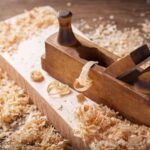Are you looking to add a touch of rustic charm to your home with a whitewash finish on your woodwork? If so, you’ve come to the right place.
In this article, we will explore the art of whitewashing finished woodwork and provide you with all the information you need to achieve a beautiful and timeless look for your space. From understanding the technique and choosing the right materials to applying the whitewash and maintaining its beauty, we’ve got you covered.
Whitewashing finished woodwork is a popular technique that involves applying a translucent white stain to wood surfaces, allowing the natural grain and texture of the wood to show through. This technique is perfect for adding a weathered or vintage look to furniture, trim, or other wooden elements in your home. In this section, we will delve into the fundamentals of whitewashing finished woodwork, equipping you with the essential knowledge needed to embark on this DIY project.
Before we dive into the nitty-gritty details of whitewashing finished woodwork, it’s important to understand the process and gather all the necessary materials. From sandpaper and cleaning supplies to different types of whitewash options, having the right tools at your disposal is crucial for achieving a successful outcome.
In addition to materials, we’ll also cover how to prepare your woodwork for whitewashing through sanding and thorough cleaning. So, if you’re ready to learn how to breathe new life into your wood surfaces with a fresh coat of whitewash, let’s get started.
Materials Needed for Whitewashing Finished Woodwork
When it comes to whitewashing finished woodwork, having the right materials is essential to achieve the desired effect. Here are the key materials you will need to successfully whitewash your woodwork.
Materials Needed
Whitewash Solution
The first and most important material you will need is a whitewash solution. You can either purchase a pre-made whitewash solution from a home improvement store or create your own using water, paint, and other additives. Be sure to choose a solution that is suitable for the type of woodwork you are working with, whether it be trim, cabinets, or furniture.
Paintbrushes or Roller
You will also need paintbrushes or a roller for applying the whitewash solution to your woodwork. The choice between brushes or rollers will depend on the size and intricacy of the woodwork you are whitewashing.
Sandpaper and Tack Cloth
Before applying the whitewash solution, you will need sandpaper to smooth out any rough patches on the woodwork and create an even surface for the whitewashing process. Additionally, a tack cloth is essential for removing any dust particles left behind from sanding.
Protective Gear
It’s important to protect yourself and your surroundings while whitewashing finished woodwork. Be sure to have gloves, safety goggles, and drop cloths on hand to protect your skin, eyes, and floors from potential splatters during the whitewashing process.
By gathering these essential materials in advance, you can ensure that you are fully prepared for the task of whitewashing your finished woodwork effectively and efficiently.
Preparing the Woodwork for Whitewashing
After deciding to give your woodwork a fresh, whitewashed look, the next step is to properly prepare the surface for the application of the whitewash. This involves sanding and cleaning the wood to ensure that the whitewash adheres evenly and smoothly. Here’s a step-by-step guide on how to prepare your woodwork for whitewashing:
1. Sanding: Before applying the whitewash, it’s important to sand the surface of the wood. This will help remove any existing finish or rough patches on the wood, allowing for a smoother and more even application of the whitewash. Use a medium-grit sandpaper to start, and then finish with a fine-grit sandpaper for a silky-smooth finish.
2. Cleaning: Once you’ve finished sanding, it’s crucial to thoroughly clean the woodwork to remove any dust or debris from the sanding process. Use a damp cloth or sponge to wipe down the entire surface, ensuring that it is completely free from any leftover dust or dirt. Allow the wood to fully dry before proceeding to apply the whitewash.
3. Filling in Gaps: While preparing your woodwork, take this opportunity to fill in any gaps or cracks in the wood using wood filler. Smooth out the filler and allow it to dry according to manufacturer instructions before moving on to applying the whitewash.
By following these steps and properly preparing your woodwork for whitewashing, you can ensure that your finished product will have an even and professional-looking appearance.
Once you have completed sanding and cleaning your woodwork, you’re ready to move on to choosing and applying the right whitewash for your project. Keep reading for guidance on how best accomplish this step.
Choosing the Right Whitewash
When it comes to whitewashing finished woodwork, choosing the right whitewash is essential to achieving the desired result. There are several options and techniques to consider when selecting the perfect whitewash for your project.
One popular option for whitewashing woodwork is using a thinned-down white paint. This method allows you to customize the opacity of the finish by adjusting the ratio of paint to water. Another option is to use a pickling stain, which is designed specifically for creating a whitewashed look on wood surfaces. Pickling stains come in a range of colors, allowing you to achieve different tones of whitewash depending on your preference.
In addition, there are pre-mixed whitewash products available on the market that offer convenience and ease of use. These ready-to-use whitewashes come in various shades and can be applied directly to the wood without any mixing required. Regardless of the option you choose, it’s important to test the whitewash on a small, inconspicuous area of the woodwork before applying it to the entire surface to ensure it meets your expectations.
Here are some techniques for applying whitewash to finished woodwork:
- Brushing: Using a brush allows for controlled application and helps achieve an even coat of whitewash.
- Ragging: Applying whitewash with a rag can create a more subtle and textured finish.
- Spraying: For larger surfaces, using a sprayer can provide efficient and uniform coverage.
Ultimately, selecting the right whitewash and technique depends on your aesthetic preferences and the specific characteristics of the woodwork you’re working with.
| Whitewash Option | Application Technique |
|---|---|
| Thinned-down white paint | Brushing or ragging |
| Pickling stain | Ragging or brushing |
| Pre-mixed whitewash products | Brushing or spraying |
Applying the Whitewash
Now that you have prepared your woodwork and chosen the right whitewash, it’s time to apply the whitewash for a beautiful finish. Follow these steps for a step-by-step guide on how to whitewash finished woodwork.
Step 1: Prepare the Work Area
Before applying the whitewash, make sure to protect the surrounding area with drop cloths or old newspapers to prevent any spills or drips from staining the floor or furniture. Additionally, ensure proper ventilation in the room by opening windows or using fans to reduce the fumes from the whitewash.
Step 2: Apply the First Coat
Using a paintbrush or rag, apply an even coat of whitewash to the woodwork in long, smooth strokes. Work in small sections at a time and be sure to cover all areas of the woodwork. Allow this first coat to dry completely before moving on to the next step.
Step 3: Sanding and Distressing (Optional)
If you want a distressed look for your finished woodwork, use sandpaper to gently distress certain areas after the first coat has dried. Focus on edges, corners, and high-traffic areas for a naturally weathered appearance.
Step 4: Apply Additional Coats (Optional)
Depending on the desired look and coverage, you may choose to apply additional coats of whitewash. Repeat Step 2 for each additional coat, ensuring complete drying between each application. Be mindful not to apply too many coats as this can result in an overly opaque finish.
Following these steps will help you achieve a beautiful whitewashed finish on your woodwork. Once completed, allow everything to dry thoroughly before moving on to the next stages of maintenance and enhancement.
Tips for Achieving the Perfect Whitewash Finish
Achieving the perfect whitewash finish on your woodwork requires careful attention to detail and a few key tips to ensure the desired result. Here are some tips to help you achieve the perfect whitewash finish on your finished woodwork.
First, it’s important to properly prepare the woodwork before applying the whitewash. This includes sanding the surface to create a smooth and even base for the whitewash. Additionally, cleaning the woodwork to remove any dust, dirt, or debris is crucial for ensuring a clean and uniform application of the whitewash.
When choosing the right whitewash for your finished woodwork, consider both water-based and oil-based options. Water-based whitewashes tend to create a more subtle and translucent finish, while oil-based whitewashes provide a more opaque and dramatic effect. Consider the look you want to achieve when selecting the type of whitewash for your project.
Once you have selected your preferred whitewash, follow a step-by-step guide for applying it to your finished woodwork. This may include using a brush or rag to apply the whitewash in even strokes, working in small sections at a time to ensure consistent coverage. Additionally, consider applying multiple layers of whitewash if you desire a deeper and more pronounced effect.
By following these tips and techniques, you can achieve a beautifully whitewashed finish on your woodwork that adds charm and character to any space. Experiment with different options and decorative techniques to enhance the look of your whitewashed finished woodwork and create a timeless appeal in your home or workspace.
Maintaining Whitewashed Woodwork
Once you have successfully whitewashed your woodwork, it’s important to ensure that you maintain its beautiful finish. Proper care and cleaning will not only keep your whitewashed woodwork looking its best but also prolong its lifespan. Here are some maintenance tips for keeping your whitewashed woodwork in top condition:
1. Regular Dusting: Dust and debris can accumulate on the surface of your whitewashed woodwork, dulling its appearance over time. To prevent this, make sure to dust the surfaces regularly with a soft cloth or a duster. This simple step will help keep your woodwork looking clean and fresh.
2. Gentle Cleaning: When it comes to cleaning your whitewashed woodwork, it’s important to use gentle methods to avoid damaging the finish. Avoid using harsh chemicals or abrasive cleaners that can strip away the whitewash. Instead, opt for a mild soap and water solution applied with a damp cloth for regular cleaning.
3. Preventing Water Damage: Since whitewash is a water-based finish, it’s essential to protect your woodwork from excessive moisture. Make sure to wipe up any spills or water droplets promptly to prevent them from seeping into the wood and causing damage.
Remember that proper care and cleaning are essential for maintaining the timeless beauty of whitewashed finished woodwork. By following these tips, you can ensure that your woodwork continues to look stunning for years to come.
So there it is – maintaining and caring for your beautifully whitewashed finished woodwork is effortless when you do so correctly.
Enhancing the Look of Whitewashed Woodwork
Whitewashed woodwork can add a beautiful, rustic look to any space, but if you want to take it a step further, there are various decorative techniques and ideas that can enhance the overall look. Whether you’re looking to add some character to your whitewashed woodwork or create a specific aesthetic, there are several options to consider.
One popular technique for enhancing the look of whitewashed woodwork is distressing. This involves intentionally creating dents, scratches, and other signs of wear and tear on the wood to give it a weathered and aged appearance. You can achieve this by using tools like hammers, chains, or even sandpaper to create texture and imperfections in the wood. Once the distressing is done, you can apply an additional layer of whitewash to further enhance the effect.
Another way to enhance the look of whitewashed woodwork is by adding decorative stenciling or hand-painted designs. This allows you to personalize the woodwork and add unique patterns or imagery that complement your overall design aesthetic. Stencils can be used with a contrasting color to create bold designs, while hand-painting allows for greater creativity and customization.
In addition to distressing and stenciling, other decorative techniques such as bleaching, pickling, or adding glazes can also be used to achieve different effects on whitewashed woodwork. These techniques can help create varying levels of depth and texture in the finish, adding visual interest and dimension to the wood. By experimenting with different decorative techniques, you can truly make your whitewashed woodwork stand out in any space.
| Enhancing Technique | Description |
|---|---|
| Distressing | Create intentional wear and tear for a weathered look |
| Stenciling/hand-painting | Add personalized designs for a unique touch |
| Bleaching/pickling/glazing | Create depth and texture for visual interest |
Conclusion
In conclusion, whitewashing finished woodwork is a classic and timeless technique that can bring a sense of warmth and character to any space. Whether you are looking to refresh the look of your old furniture or add a rustic charm to your interior decor, whitewashing provides a versatile and beautiful finish that can truly transform the appearance of woodwork.
By following the steps outlined in this article, you can learn how to whitewash finished woodwork with ease and achieve stunning results.
The process of whitewashing finished woodwork may seem daunting at first, but with the right materials and techniques, it can be a rewarding DIY project. From preparing the woodwork by sanding and cleaning it to choosing the appropriate whitewash and applying it with precision, each step plays a crucial role in achieving the perfect finish.
Additionally, maintaining and enhancing the look of whitewashed woodwork involves regular care and cleaning, as well as exploring decorative techniques to further elevate its aesthetic appeal.
Ultimately, embracing the timeless beauty of whitewashed finished woodwork allows you to appreciate the natural grain and texture of the wood while adding a touch of elegance to your home decor. The soft, milky hue created by whitewashing complements various design styles, making it a versatile choice for both modern and traditional interiors.
So whether you’re drawn to its rustic charm or want to create a beachy, coastal vibe in your space, learning how to whitewash finished woodwork opens up endless possibilities for enhancing the visual appeal of your furniture and interior surfaces.
Frequently Asked Questions
How Do You Whitewash Wood That Has Been Varnished?
Whitewashing varnished wood requires thorough preparation. Start by sanding the surface to remove the varnish. Then, apply a mixture of water and white paint, wiping off any excess to achieve the desired look.
How Do You Whitewash Unpainted Wood?
When whitewashing unpainted wood, it’s essential to first clean the surface and sand it lightly to ensure proper paint adherence. Then, apply a watered-down white paint mixture, allowing the wood grain to show through.
How Do You Whitewash Stained Wood Trim?
Whitewashing stained wood trim involves removing any existing finish with sandpaper or chemical strippers. After cleaning and prepping the surface, apply a thin layer of diluted white paint using a brush or rag, and wipe off any excess for a more subtle whitewashed effect on the trim.

Hi everyone! I’m a woodworker and blogger, and this is my woodworking blog. In my blog, I share tips and tricks for woodworkers of all skill levels, as well as project ideas that you can try yourself.





